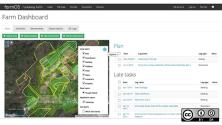Of all the beverages out there, one stands out among the rest. Tea.
Coffee and chocolate can be a treat during the day, but you don't usually make your coffee with an espresso machine or your chocolate over a stove. Tea on the other hand is best, and most often enjoyed, by brewing it yourself. And, like open source, it's that element of do-it-yourselfness that makes it special.
Tea is hackable, too. It comes in all kinds of flavors, ingredients, colors, and even shapes that makes experimenting with it easy and fun. Maybe this experimental nature reminds you of the way a full-stack programmer creates an application from the first line of the deployment.
With tea, you can combine various types of tea, creating new mixtures. You can adjust the proportions and vary the brew times. And, then, tasting your creations educates your palate. Perhaps, in much the same way that programming in low-level languages teaches you how to appreciate the implementation of a particular algorithm.
Tea: remix and modify
First, choose a group of three or four single varieties that have similar brew times. For example, Assam, Keemum Congou, and Yunnan. They have 4 minute brew times and are "pure" teas.
Just like an algorithm, tea needs time to reach its full potential. If you don't brew it long enough, the flavors won't develop fully. Too much time, and it will end up bitter and unpleasant. (Note: some bitter can be good.)
Tea usually comes in one of two ways: loose leaf or in a sachet (or bag). Using tea bags is more predictable, while loose leaf tea makes for a more experimental process. When I shop for loose leaf teas, I go to a place that has the wonderful smell of wood, smoke, and spices. I stay a while, talking to the shopkeeper, opening tin cans, and tasting the brew of the day. And, I usually leave with a few paper bags of well-known tea blends as well as a few new ones I want to try.
Try teas from all over the world, like a green Chinese tea, a black Indian tea, and some varieties from Ceylon or Kenya. Then, think about adding color to the mix. Maybe you could use your favorite gradient-descent algorithm to help make adjustments.
Black tea: get stuff done
For many, a black morning tea is the first beverage of the day. Black teas full leaves and are fermented to concentrate the caffeine to the maximum. They help get your motor running so that you can learn a new programming language or crush that bug that was eluding you. Two varieties I like for a full day of meetings are Assam or Yunnan. Black tea is a great companion for plowing through email, or maybe you don't even touch email until you have finished that first mug of steaming black tea.
It gives me the speed of mind and fingers to start the day with a few commits.
Tea time: take a break
The quintessential "tea time" or "afternoon tea" offers the chance to take a break, breathe, and let your brain rest. Taking regular breaks is essential for doing better work in the long run, and being happier in general. Afternoon teas are a category unto themselves and usually come as pure or flavored.
A favored-by-many flavored tea example is Earl Grey. I add it to my English Breakfast varity sometimes because it takes a bit off the edge off with its citrus flavor. A smoked tea example is Lapsang Souchong that some love and some don't. It's can be an aquired taste.
Black tea can be enjoyed again in the afternoon when your making code reviews and finishing up your programming for the day.
To relieve stress from work in the afternoon, choose an oolong tea. These are semi-fermented and have lower levels of caffeine, but a pungent flavor. You might also enjoy Pu-erh or red tea, which is fermented and aged, and has a lower amount of caffeine. These can be mixed with strong flavors like vanilla and cinnamon. I recommend stress relieving teas for documentation.
Relax, Jac!
Green or white teas are great for the evening when it's time to stop work and relax. I like to sit on the couch with a cup to read sci-fi or learn about a new open source programming language that has just popped up. It keeps me in a relaxed state, which helps me better solve problems for the next day, without putting me to sleep quite yet.
Some flavored teas for the evening, include: Japanese lime green tea, Jasmine tea, and Moroccan tea mixed with mint leaves. Licorice and other flavors, like ginger, can be added, but Chinese or Japanese green teas do have a fine flavor all by themselves. Try Silver Needle, Bai Mudan, or any of the other big-leaf Japanese and Chinese teas. They come in all kind of shapes and colors.
Sharing your tea
Then, share your recipes with others. Find an online forum, like r/tea, or in-person group in your city to share types of tea, proportions used, and brew times, with any additional notes. Have fun!






4 Comments